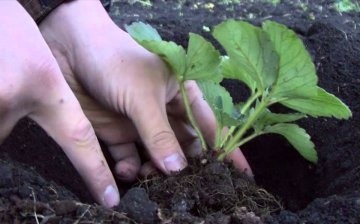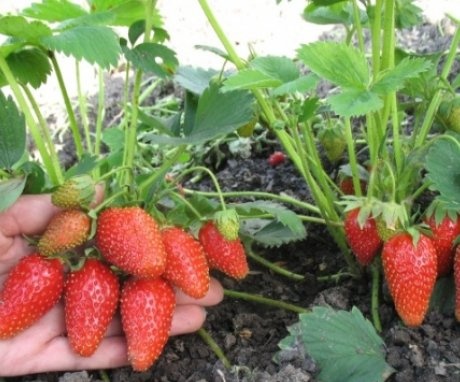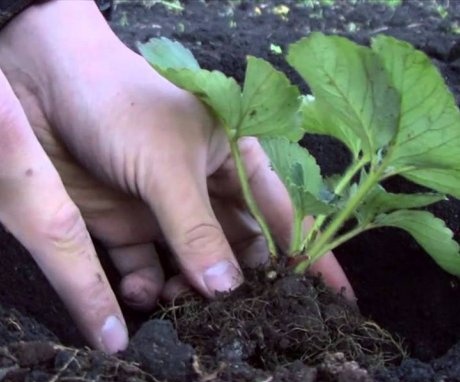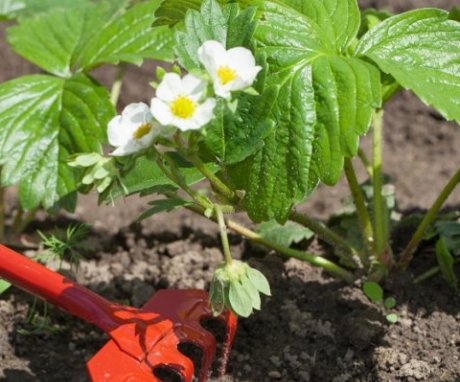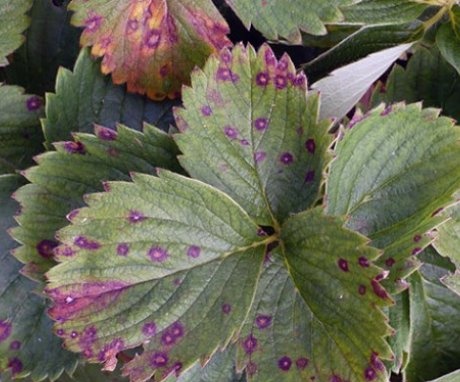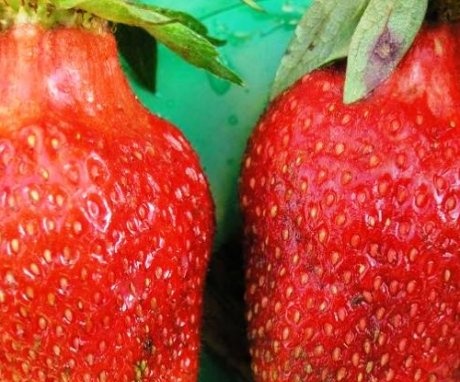Strawberry "Cardinal": all about cultivation of the variety
Strawberry "Cardinal" is a product of many years of breeding work of American specialists, aimed at breeding a variety of long-term fruiting berries of early ripeness. The first harvest of these fruits begins in June, after planting the very first seedlings, in the same year.
Content:
- Description and advantages of the variety
- Reproduction and planting
- Care Tips
- Diseases and pests, the fight against them
- Advantages and disadvantages of the variety
Description and advantages of the variety
"Cardinal" has tall, covered with a sparse amount of leaves, bushes. The size of the leaf is large, the color is dark, deep green (below with a blue tint), with red scales, boat-like shape. Antennae grow long, with numerous bushes, giving a second yield in the autumn (in October).
Despite the fact that the variety is not equally fruitful on one- and two-year-old shoots, its indisputable advantage is the possibility of re-harvesting (on newly formed rosettes).
In addition, the later harvest significantly exceeds the initial one, in terms of qualitative and quantitative indicators:
- much larger berries, reaching a weight of 80 g.
- harvest from a bush - up to 1 kilogram
- exceeding volumes compared to the first yield
Berries of the "Cardinal" variety are distinguished by spindle-shaped fruits, the high neck of which does not have seeds. Seeds of a light golden hue, in turn, are strewn with the surface of the fruit, dark cherry, smooth, shiny. The consistency of the pulp is dense, sugar, fibrous, crunches when chewed, because it has increased hardness, compared to other types of strawberries, may have small voids.
The berries are tasty, have a pleasant aroma, with a strawberry hue, sweet and sour.
They are stored for a very long time and have excellent transportation properties (they are delivered to the destination safe and sound, do not crumple even when struck by a fall). Faded rosettes from which the fruits are harvested are not suitable for the next plantings, and the process of rooting fresh bushes is quite long and difficult.
Reproduction and planting
Attention: choose seedlings carefully, the leaves of the plants should have red scales and a dark green tint. When planting a plant, preference should be given to a light, fresh type of soil, loamy or sandy loamy low acid type. The berry requires active high-quality feeding. The growth and reproduction of a plant of this type occurs due to the mustache, which is actively formed in the late summer period.
Bushes should be planted in the ground in early spring or autumn.
The methods of planting young bushes are as follows:
- In two rows (the most suitable method for the summer period): the rosettes are planted in two strips, maintaining a distance of 35 cm between bushes and about 80 cm between rows.
- In one row (used in the spring-autumn period): the bushes are planted, keeping a distance of 15 cm.
Consider that the bushes should take root before the onset of cold weather (when planting in the fall). Important: with a close passage of groundwater, the beds should be raised higher. "Cardinal" does not tolerate droughts, its exactingness to timely soil moistening is very high.
Spring care features:
- cleaning from beds of dried foliage
- preventive treatment with bordeaux liquid
- loosening of the top soil layer
- weed control
- covering the surface soil layer near the outlets
Summer care subtleties:
- pest and parasite control using modern means
- during the period of emerging outlets, to produce mineral dressing
- at the end of summer - alternating with organic type of feeding
The rather high height of the rosette (reaching a height of about 50 cm) ensures that the fruits are not in contact with the upper layers of the soil. Thanks to this very important factor, the berries receive a sufficient amount of sunlight and their ripening is accelerated. This is facilitated by the scarcity of the deciduous cover of the bushes.
Care Tips
Please note: on the recommendation of breeders, excess antennae should be removed. In this case, the plant will increase fruiting (and not the growth of bushes), the berry will increase in size.
Caring for the "Cardinal" variety is elementary:
- regular watering
- constant weeding of bushes
- preventing the land from drying out under the bushes (otherwise, the growth of the plant will deteriorate, the fruits will significantly decrease in volume, the yield will decrease)
The nuances should be taken into account:
- When preparing plants for planting, cultivate the bed in advance (approximately 1.5-2 months).
- After planting in the fall, destroy the weakened and showing signs of the disease.
- Regularity glaze will provide high taste qualities of the product.
- Watering should be done in the morning to avoid drying out in the evening.
- The water temperature during irrigation should not be lower than 20 degrees.
- Before the first berries appear, the rosettes should be watered with a watering can, from above; with the appearance of fruits - watering changes to root.
- Use nitrogen-type fertilizers sparingly, with increased caution, since its excessive use provokes damage to the plant powdery mildew.
- Use organics more often in care.
- The soil for planting should be fertile.
Obtaining high yields is not an easy and troublesome business, however, with an effort, it is quite possible to achieve this goal. Delicious, fleshy fruits will delight loved ones, and excess harvest can be profitably sold.
Diseases and pests, the fight against them
The variety of these berries is susceptible to powdery mildew attacks (especially in the May period), but it is highly resistant to gray mold attacks. Spotting does not threaten the Cardinal either.
In order to avoid the harmful effects of powdery mildew, in the spring it is necessary fungicidal treatment and ensuring good circulation of air masses within the plantings.
Planting seedlings too densely is unacceptable, as this can cause diseases in plants.
However, a considerable number of gardeners recommend compacting the planting, in order to subsequently remove damaged bushes. Therefore, in this situation, an individual approach is recommended, which is different in each case.
Advantages and disadvantages of the variety
Strawberry "Cardinal" has both a number of undeniable advantages and significant disadvantages.
Negative characteristics of the variety:
- Weak resistance to powdery mildew.
- The antennae bear fruit at the end of the flowering period, however, their survival rate decreases due to this property: after fruiting, the bushes cannot be applied. For this reason, the reproduction of the Cardinal is stretched out over time.
The advantageous properties of the plant:
- Large fruit size.
- The possibility of planting plants in the autumn-spring period.
- Duration of storage and excellent resistance to transportation.
- High survival rate of well-selected rosettes (not prone to flowering).
- Resistance of berries to possible damage.
- Yield volumes, including from the outlet.
- The abundance of antennae.
- High anti-putrefaction (gray rot is actually not capable of causing significant damage to the plant).
- Long-term fruiting, double seasonal yield.
- Taste characteristics and attractive appearance.
- Excellent frost resistance (tolerates temperatures lower than 15 degrees).
Obviously, the positive properties of the Cardinal variety are many times greater than the negative ones. Therefore, this type of strawberry is extremely popular and loved by a huge number of gardeners. "Cardinal" has received a lot of praise for fruiting on young, not yet rooted, bushes. Fans of the variety grow berries using the ampel type or vertically arranged trellises.
More information on how to properly care for strawberries can be found in the video:
The discerning taste of connoisseurs is completely satisfied with this variety, which differs from its brethren in its delicate taste and the most delicate strawberry, bright aroma. "Cardinal" is preferred by amateurs strawberry, for its indisputable advantages, excellent keeping quality of berries. Novice gardeners also purchase a variety, since it does not require much labor and is quite affordable, in terms of care, even for an inexperienced person.
In skillful and caring hands, the plant will undoubtedly show its best sides and will delight you with the volume of harvest, taste characteristics and excellent presentation. To achieve success in growing the Cardinal variety, it is only necessary to carefully observe and timely follow all the care recommendations of the breeders.
This variety of strawberries is recommended for consumption both fresh and in the preparation of various mousses, jams, compotes, jellies - canned berries are in no way inferior to their counterparts and also have excellent taste properties.





